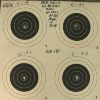ATTHECROSS
Member
- Joined
- Jan 4, 2017
- Messages
- 43
Hello Everyone-
Just wondering if anyone had any training technique or personal preference on how to best develop a nice steady gun when aiming and then pulling through the trigger. I don't shake wildly or anything but I would like to learn to be as still as possible.
Thanks for the help!
Just wondering if anyone had any training technique or personal preference on how to best develop a nice steady gun when aiming and then pulling through the trigger. I don't shake wildly or anything but I would like to learn to be as still as possible.
Thanks for the help!






